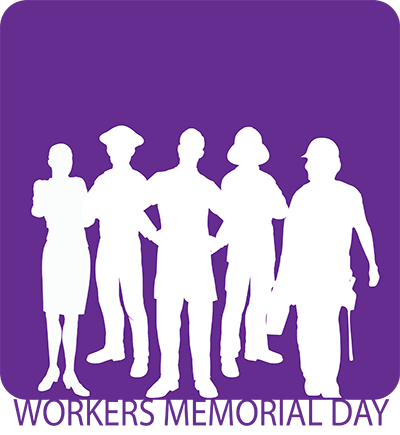Workers Memorial Day

Workers Memorial Day, April 28, was established to recognize workers who died or suffered from exposures to hazards at work. It also encourages us to think of ways in which we all can help to achieve the goal of safer and healthier workplaces.
In 2015, 4,836 workers in the United States died from injuries sustained at work – an average of 13 deaths per day (1). The number of deaths from occupational illnesses is even greater: an estimate for 2007 was over 53,000 deaths (2). There is no single statistic that sums up all of the non-fatal occupational injuries experienced by workers in the U.S., however several surveillance systems each tell part of the story. In 2015, the Bureau of Labor Statistics received reports from employers of nearly 2.9 million injuries and illnesses to private industry workers and 752,600 injuries to state and local government workers (3). In the same year, an estimated 2.7 million work-related injuries were treated in emergency departments, resulting in 85,000 hospitalizations (National Institute for Occupational Safety and Health, unpublished data, 2017).
Occupational injuries and illnesses have broad social and economic impacts on workers and their families, on employers, and on society as a whole. There are several ways to estimate those consequences, such as methods that focus on medical costs, productivity losses, health-related quality of life losses, or risk-money tradeoffs that consider pain and suffering. Based on methods that focus on medical costs and productivity losses, the societal cost of work-related fatalities, injuries, and illnesses was estimated at $250 billion in 2007 (2). Methods that include consideration of pain and suffering would result in a higher estimated societal cost (4). NIOSH is working to better describe the burden of fatalities, injuries, and illnesses suffered by workers; additional information is available at http://www.cdc.gov/niosh/programs/econ/risks.html(https://www.cdc.gov/niosh/programs/econ/risks.html) . While significant progress has occurred since the passage of the Occupational Safety and Health Act, much more remains to be made. Even as we continue efforts to eliminate the legacy hazards of the 20th Century, we are also called to address the emerging challenges of the 21st Century economy.
On Workers Memorial Day 2017, we look forward to a future in which every job is a safe job, and no one becomes injured or made ill by work. Additional information on workplace safety and health is available online or by telephone, 1-800-CDC-INFO (1-800-232-4636).
- Statement by NIOSH Director John Howard, M.D., Workers Memorial Day 2017
Morbidity and Mortality Weekly Report, Workers Memorial Day
Each year, NIOSH collaborates with the CDC’s Morbidity and Mortality Weekly (MMWR) report to publish an edition of MMWR that features some of the newest data, case reports, and other findings from NIOSH surveillance and research activities. The reports published in MMWR serve to inform the medical and public health community about new and existing threats to workers’ health.
- CDC Morbidity and Mortality Weekly Report, April 28, 2017 (Workers Memorial Day issue):
- Workers Memorial Day — April 28, 2017
- Occupational Fatalities Resulting from Falls in the Oil and Gas Extraction Industry, United States, 2005–2014
- Announcement: National Campaign to Prevent Falls in Construction — United States, 2017
- QuickStats: Percentage* of Adult Workers Aged ≥18 Years Who Reported Being Threatened, Bullied, or Harassed While on the Job,† by Sex — National Health Interview Survey, United States, 2010 and 2015§
References
- National census of fatal occupational injuries in 2015. Bureau of Labor Statistics. https://www.bls.gov/news.release/pdf/cfoi.pdf.
- Leigh JP. Economic burden of occupational injury and illness in the United States. Millbank Q 2011;89:728–72.
- Employer-reported workplace injuries and illnesses in 2015. Bureau of Labor Statistics. https://www.bls.gov/news.release/pdf/osh.pdf.
- Haddix AC, Teutsch SM, Corso PS, eds. Prevention effectiveness: a guide to decision analysis and economic evaluation. New York, NY: Oxford University Press;2003:74.
- Page last reviewed: April 22, 2014
- Page last updated: April 26, 2017
- Content source:
- National Institute for Occupational Safety and Health Education and Information Division


 ShareCompartir
ShareCompartir